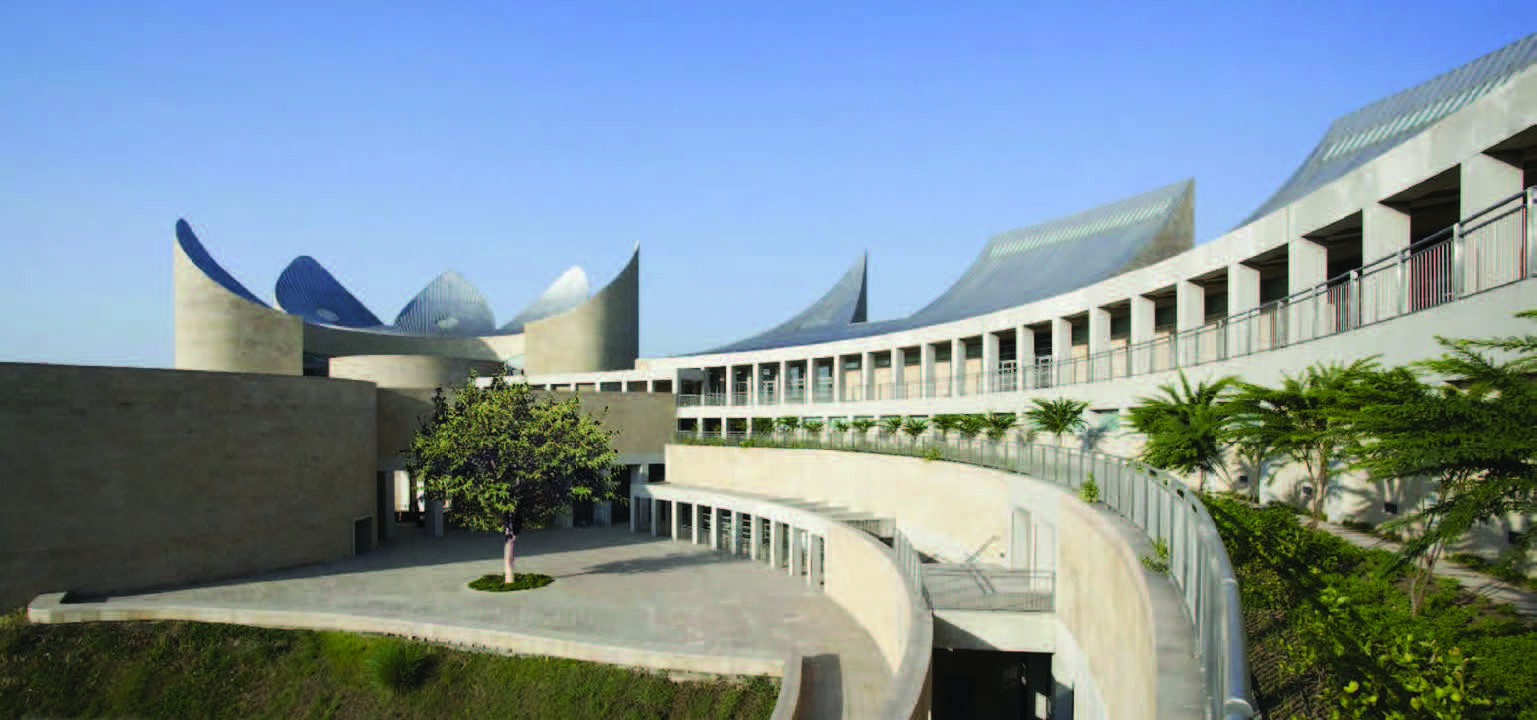
A masterpiece of rich Sikh culture and religious history, the `Virasat-e-Khalsa` was dedicated to the nation in the Sikh holy city of Anandpur Sahib, the birthplace of the Khalsa, amidst an elaborate religious ceremony , on November 25, 2011.

The Rs.300 crore project was opened by Punjab Chief Minister Prakash Singh Badal in the presence of Bharatiya Janata Party (BJP) president Nitin Gadkari, Art of Living founder Sri Sri Ravi Shankar and others.
 Conceived as a repository of the rich heritage of the `Khalsa`, showcasing the history and culture of Punjab, the heritage complex has been built to emphasize the eternal message of the Sikh gurus.
Conceived as a repository of the rich heritage of the `Khalsa`, showcasing the history and culture of Punjab, the heritage complex has been built to emphasize the eternal message of the Sikh gurus.
Called the Khalsa Heritage Complex (KHC), it is touted as a landmark monument of one of the youngest religions in the world.
The project, announced in April 1999, was originally expected to be completed by September 2004 to coincide with the celebrations of the 400th year of the Golden Temple. However, the project got delayed for one or the other reason, better known to the authorities concerned. The monument dedicated is incomplete and only the first phase of the whole KHC project.
Being built on a 100-acre site at Anandpur Sahib, 85 km from Chandigarh, KHC stands at a site that is the birthplace of the Khalsa Panth, the present day Sikh religion. The second holiest Sikh shrine, Takht Keshgarh Sahib, is located here.
It was here in 1699, on the day of Baisakhi, that the 10th Sikh master, Guru Gobind Singh, founded the Khalsa Panth and baptized the `Panj Piaras` (the first five baptized Sikhs known to be the loved ones of the guru).
Boston-based Israeli-architect Moshe Safdie has designed the complex, which is shaped like open hands offering prayers. The monument is termed as a “wonder in the making”.
Tribute to tradition 
The project, which has been shaped like hands offering prayers, unfolds Sikh history and tradition -like never before.
People working on the project claim that a museum like this has never been built before in the country. It has got no precedent, no comparison.
Made up of building materials from all over India, the project is an architectural miracle and the world’s foremost, comprehensive Sikh heritage centre.
Moshe Safdie, the internationally acclaimed Boston-based Israeli architect, has designed the Khalsa Heritage Complex. Punjab Chief Minister Prakash Singh Badal handpicked Safdie, during one of his visits abroad in mid ’90s.
 The project houses a museum, which will have souvenirs related to Sikh history comprising all 10 Sikh Gurus, Guru Granth Sahib and Sikh rulers like Maharaja Ranjit Singh. The museum will also have scriptures written by Guru Gobind Singh.
The project houses a museum, which will have souvenirs related to Sikh history comprising all 10 Sikh Gurus, Guru Granth Sahib and Sikh rulers like Maharaja Ranjit Singh. The museum will also have scriptures written by Guru Gobind Singh.
The museum is conceived by Amardeep Behl, a Delhi-based designer running AB Design Habit, who is also working on restoration of Sri Harmandar Sahib.
The project has two main complexes, which are joined with a connecting ceremonial bridge. The canopy on this bridge is an architectural experiment and is situated in the opposite direction of the sun and does not provide any shade.
The western complex houses an auditorium with a seating capacity of 400. It will have temporary exhibition galleries and a library, housing all journals, magazines, books and periodicals on Sikhism.
The eastern complex has a north wing also known as flower building. It has another part, which is called boat building or heritage building.
The roof of the flower building is shaped in form of five petals – depicting Panj Piaras of Guru Gobind Singh. Each petal will house an exhibit tracing the life history of all gurus from birth to attaining salvation/ martyrdom. These will be permanent exhibits. The petal at the highest altitude will have information and exhibits on Guru Granth Sahib.
The rooftops of all petals have been covered with special stainless steel sheets. At night the entire building will be illuminated with its large silhouette being reflected in seven acres around. It will also illuminate the night skyline of the historical city of the birth of the Khalsa.
Exhibit galleries
At the entry of the museum, permanent exhibits, depicting Punjab before birth of Guru Nanak, have been placed. These will showcase the climate, culture and life of pre-Guru Nanak times. The ceiling of this heritage building has been made of glass and its floor will be covered with water. The aim of this exhibit is to make the visitor introspect his life.
Thematic carpets will adorn walls of this part of building for which weavers from Mirzapur have been roped in. Next the visitor is greeted with the thought-provoking concept of Ek Onkar – this mool mantra will echo all around this exhibit. This exhibit, with special sound effects, is situated in a drum-like building where lights will create an image of Ek Onkar and an audio message will highlight core principles of Sikhism.
Then starts a mesmerising journey into the lives of first five Gurus in the five petals of the flower building. These five petals tell tales from Guru Nanak Dev to Guru Arjan Dev.
The first petal will have the milieu of the times Guru Nanak Dev was born in, tracing his life with travels (udasi) undertaken. Further there will be galleries depicting achievements of Guru Angad Dev and Guru Amardas. One of the galleries is divided into two, by recreating a baoli in the middle, to highlight gurus contribution. It will have leather and shadow puppets with painted murals in background.
The gallery in the fourth petal contains exhibits on the contribution of Guru Ram Das, including the construction of the city of Ramdaspur, adding 11 ragas to existing corpus of Gurbani and the Lavan. The city of Ramdaspur has been recreated in an embroidered creation.
The gallery in the fifth petal showcases key events in history of Sikhism: construction of Harmandar Sahib and writing and installation of Adi Granth. A pathway leading to the gallery will have a replica of Harmandar Sahib. The gallery also has an ethereal, glowing representation of Prakash Sthal – the place of the Adi Granth in Harmandar, in the centre. Around this central installation are shown stories related to the establishment of Adi Granth. Four doorways around it recreate different scenes describing the life and times of Guru Arjan Dev.
There is another gallery depicting Guru Arjan Dev’s martyrdom in the form of a sculpture on the terrace.
Here, the events of martyrdom have been narrated in an evocative manner without showcasing horrendous scenes, usually associated with Sikh museums.
There is also an exhibit, which will suggest coming together of five elements – fire, earth, water, air and space.
Petals in the crescent building will cover lifespan of Guru Hargobind, Guru Har Rai, Guru Harkrishan, Guru Teg Bahadur, Guru Gobind Singh and Gurta Gaddi. The galleries at the lower level will chronicle the trials, tribulations and triumphs of the Khalsa from Banda Bahadur to immediately after Partition, when Sikh dynamism transformed Punjab with its `E9lan, energy and resilience.





Be the first to comment